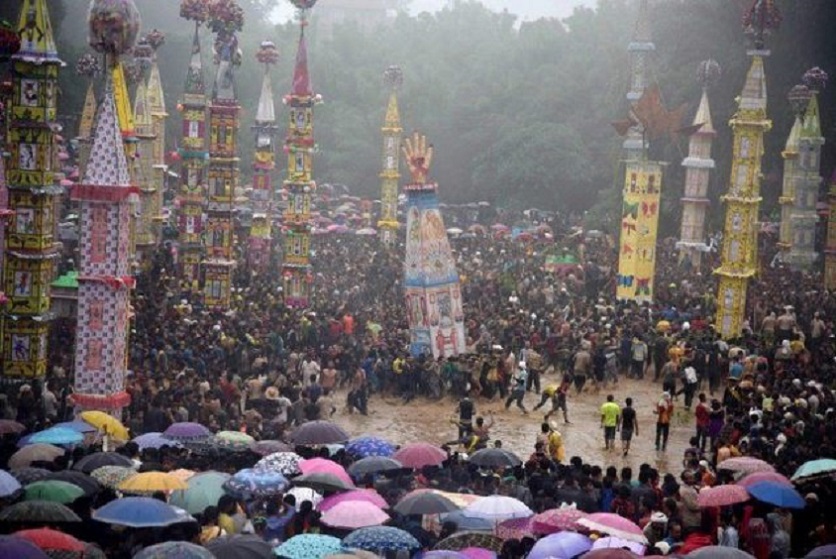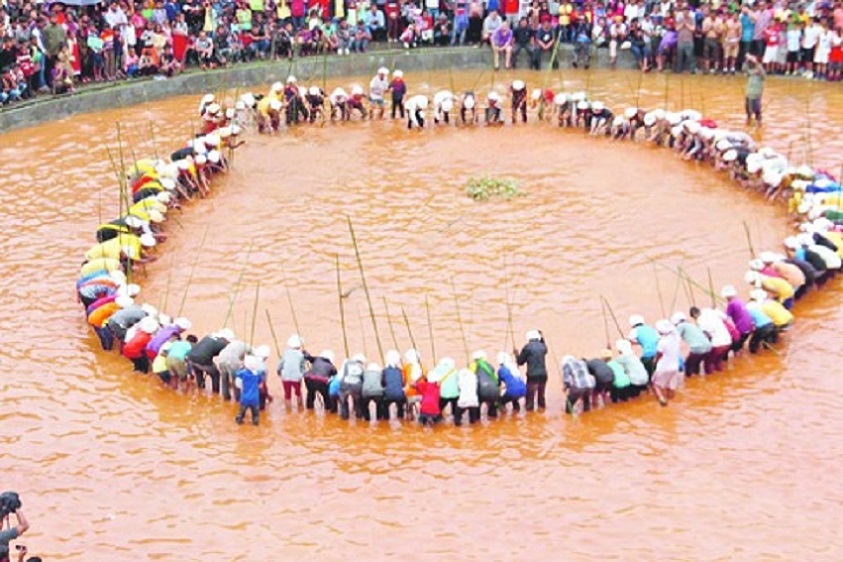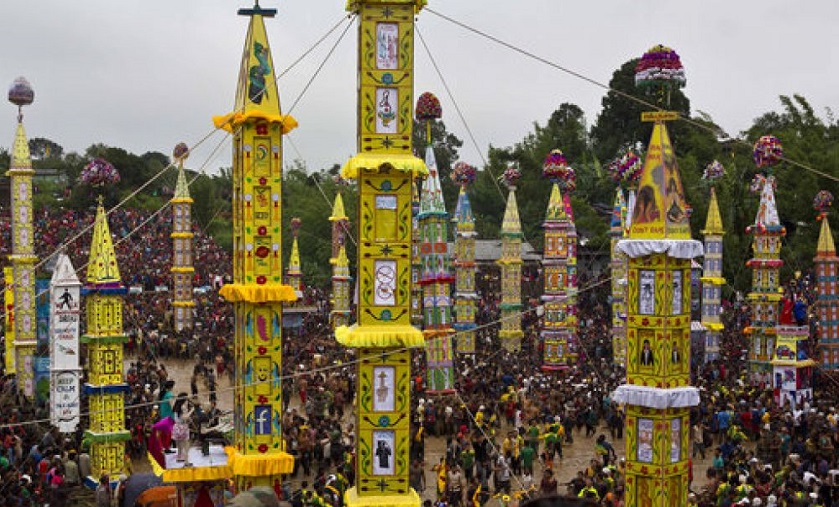Behdienkhlam Festival

Oh Meghalaya
You can update or correct this page, send photographs and/ or |
Contents[hide] |
When
It is the most important festival of the Jaintias and is celebrated mid-July every year after the sowing is over. (There are some references to its having been celebrated in late June, too.) "Khlam" means plague or pestilence'and "beh dien" means to drive away with sticks.
Organized annually by the Seinraij Jowai, this unique festival is held after the sowing season is over so as to overcome any destructive forces of nature including diseases by invoking the God for a good harvest. Interestingly, the festival is celebrated around the same time "Rath Yatra" is celebrated in other parts of eastern India. Besides being the most colourful religious festival, it is also the most important and unique dance festival of the Jaintias.
The ceremony and ritual was carried out for three [normally, four] days and on the last day, in the afternoon people gathered in a place called Aitnar and both young and old danced to the tunes of the pipes and drums.
“Aitnar” – a sacred pool.
Where
Behdienkhlam Festival is the most celebrated religious festival among the Pnars. It is popular at Jowai the District headquarters of Jaintia Hills District, Meghalaya.
What it signifies
The Behdienkhlam literally means driving away the plague as “Khlam” means ‘Plague’ and “Beh Dein” means to drive away the plague.
The unique and ancient festival of Behdienkhlam, celebrated by Jaintia or Pnar tribal community of Meghalaya, is the ritualistic expression of the relentless struggle of mankind to overcome the destructive forces of nature, including diseases, since the dawn of civilization.
This festival is also an invocation to God seeking blessings for a good harvest. Women offer sacrificial food to the spirits of the ancestors
The Behdienkhlam Festival, is celebrated by the Pnars as a form of homage which is paid to the Gods of the Seven Huts who arrived in the region from heaven and established a kingdom here.
History of its origin
According to mythology, it had been foretold that there would be a widespread plague in Ri-Pnar (Land of the Pnars). The prediction claimed that the region would suffer a violent plague that threatened to wipe out the entire tribe. Scared by this ill-fortuned prediction, the Jowai people traveled to the shrine of their protector deities Mulong, Mooralong U Mukhai and Musniang who advised them to worship the divine elements in the form of the festival of Behdienkhlam which was to be held annually. Thus, the festival is also known as the festival for chasing away the Demon of Cholera. Today, however the festival has another important significance. It is used as a prayer seeking divine blessings for a rich harvest in the year ahead.
The rituals
Rituals of the Behdienkhlam FestivalThe festival of Behdienkhlam begins with a ritual in which the Daloi or the chief of the tribe opens the proceedings with a ceremonial invocation to the Gods of the tribes through a series of religious rites. Following this is one of the most popular rituals of the festival where young men symbolize the flight of the evil spirit by beating the roof of every house in the village with bamboo poles. However, the main attraction of the Behdeinkhlam festival takes place when young men fight for the possession of a huge beam, a fight which is characterized by smearing of mud on all the participants.
A week before the festival begins, a pig is sacrificed to "thunder" (Knia Pyrthat) to ward off all evils. The underlying idea and purpose of this festival is to drive away all evils that plague human life.
The main feature of the festival is the making of the "dein khlam", "symlend" and "khnong", which are rounded, polished and tall tree trunks, felled in a reserved forest. Pine trees are never used. After letting them lie in the woods for a couple of nights, the trunks are brought to the town with great fanfare. Later, these trunks are erected in each locality and in front of individual homes.
On the fourth day, young men, led by priests, carry bamboo sticks and visit each home beating roof-tops to chase away evil spirits, especially the demon of plague to the accompaniment of drums, cymbals and chanting in Pnar. The erected "khnong" is pulled down, broken and discarded. The group is offered home-brewed rice beer by the lady of the house.
Rot (rath/ chariot)
Participating in the festival, niamtre faithful both young and old from various localities like Iongpiah, Dulong, Panaliar, Loomkyrwiang, Chilliangraij, Loomiongkjam, Tpep-pale Iawmusiang, Ummulong and Shillong Sein Raij brought their well-designed colourful ‘Rots’ or ‘Raths’ at Aitnar. (Ki niamtre is an indigenous faith.)
In 2016, more than 11 ‘rots’ were displayed during the festival.
The various rots carries with them different meaning and messages depicting the present social, political and economic issues of the state and apparently the Behdienkhlam is not all about driving away sickness but to also drive away such social evils that is inflicting the society.
The elders of the Sein Raij, including the Dolloi (religious heads) performed various ritual before the rots were brought to the pool.
The youth of each locality also try out their artistic skills by erecting gaily coloured "rots" 30-40 feet tall structures built of bamboo, coloured paper and tinsel. Competition flares as each group tries to outdo the other in making the tallest and most artistic "rot", which is similar to the "rath" of the Hindus and "tajiya" of the Muslims.
These days, the Behdienkhlam "rots" are built on wide-ranging global issues, including politics and sports. The climax of the celebrations is the tussle, as seen in a tug of war, for a large trunk known as "khnong", by two groups of people opposed to each other. The trunk, along with the colourful 'rots', is then immersed in the muddy waters of the Eitnar pool.
Earlier, the ‘Symbud Khnong’-a log of great length- was brought as thousands of people thronged to get a chance to touch it. It is believed that by touching the Khnong, it will protect them from all sorts of sicknesses besides bringing them prosperity
Religious rites and sacrifices at the sacred pool precede the immersion ceremony in the early hours of the morning. Mud is generously smeared by the participants on each other which resemble the Holi celebrations in the plains.
Concluding Ceremony

Please not to miss the puddle in the centre.
Photo Saweini Laloo, ED Times
The festival of Behdienkhlam reaches its conclusion with the Dad-lawakor ceremony in which groups of men jostle for the possession of a wooden ball, a game which is remotely similar to football. The festival ends with a final salutation to the divine powers when the women of the tribe offer sacrificial food to the Almighty.
The four day long ritual of the Naimtre of the Pnar community call “ Ka Behdienkhlam” concluded today with colour full ritual where “ Rot” from different part of Jowai Doloiship in Jayantia Hills of Meghalaya, bought to aitnar where thousand of people witness the concluding day of the Behdeinkhlam. saturday was the last day of the festival that concluded in the evening . This festival is signifies fighting against all short of social evil. This festival is being celebrated from time immemorial, as said that once the people of this place had to face serious epidemic, and thus people gather to drive away this evil. The Organiser president of the BEHDIENKHLAM festival Mr. OAR SYLEM, said that in present context we have more social evil to drive away like ,discrimination and corruption. “People from different communities also participate in this festival and we well come them, this will promote more unity”, he added.
In this This festival people dance in the pool of mud waters, as they hold tall structures called the “ROT”, groups from various localities one by one bring this “ROTS” and get into the pool of mud water and dance. The ROT,s are decorated various designs, portraying social message of winning over evil. This year all together there are eleven “Rot” that where brought from different place of the Jowai Doloiship, in all these “Rot” they carry with the write up which tells the world about the day today happening in human daily life.
Games

The Behdienkhlam Festival at Jowai, 2016
Photo UB Photos
The dancers are highly emotional when tall-decorated structures called rots and a wooden post-called khnongs were brought into the pool.
As part of the celebration, In the afternoon, a game similar to football called dat la wakor is played between two teams from the upper and lower valleys of the Myntdu River (i.e the residents of the northern side of Jowai and the southern side) each team trying to score a goal with a wooden ball. The one to score first is the winner and it is also believed that the winner would have a bumper harvest. The Daloi or traditional chief acts as the referee.
In 2016 the team of U Langdoh representing the Pynthor-Wah and team of U Sangot representing the Pynthor-Nein played at Pohsawiar.
Pynthor-wah and pynthor-nein are the two famous paddy fields of the people which are also known as the ‘Rice bowl of the Jowai’.
It is believed that, if the Langdoh’s team won the match, paddy will grow abundantly at Pynthor Wah and if the Sangot-Pasweth’s team won the match, then rice will grow abundantly at Pynthor-Nein.-
Women
This celebration is special for the ladies community, its all about preparing special dishes and inviting guests to their homes, women put on a lot jewelries specially Gold ornaments and come to enjoy the final day of the festival. Its all about merry making and doing a lot of rituals in their home.Said,Pemie Pasa,a middle aged Local women,who had put a lot of Gold plated ornaments around her neck. A “Rooster” flag is a common sight during this festival, though this is not being worshiped by the people as any god or anything else. As The traditionally belief goes, once the sun disappeared and people were in the dark, and no one was able to bring back the sun, but finally the Rooster was able to bring back the sun to everyone’s joy, this the significance of the Rooster.
The central government is funding this festival to promote tourism,said organizing President.
The authorship of this article
Behdienkhlam celebrated by Jaintia community | TNN | Jul 11, 2012 | IndiaTimes/ The Times of India
Behdienkhlam festival at Jowai | Meghalaya Times
Peter Alex Todd
[archive.html NorthEastNewsPortal] <> [Archive.html EasternPanorama]



